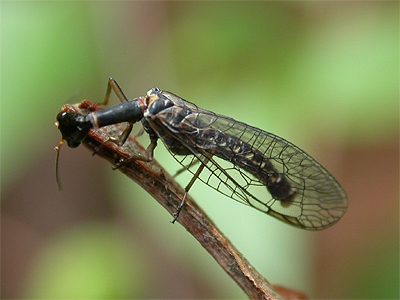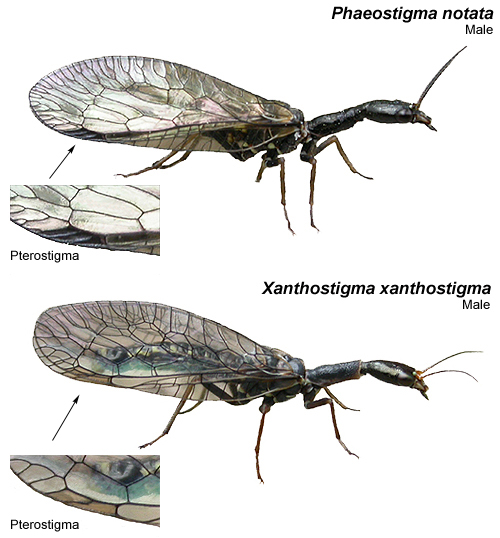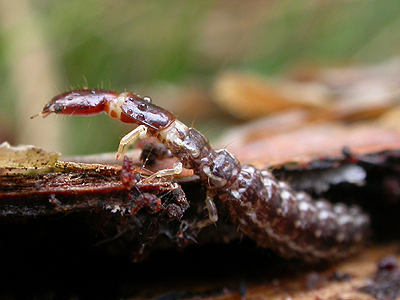

| Raphidiidae - the Snake Flies of Nottinghamshire | ||
| Snake Flies (Raphidiidae) attain an almost mythical status among some naturalists. A great many have never seen them, even after some years spent in the field and in truth, they are not something you can set out to find easily, even when armed with some level of knowledge regarding their arboreal habitat requirements. | ||
| .... |
| Why then, the need for a page
discussing two species that might take someone a few
years to find? Well the simple answer is that
Raphidioptera are poorly represented on the internet.
There are plenty of photographs showing the two species
featured here, but little literary information. Spectacularly strange looking insects (a look generated by their elongated prothorax) they are completely harmless insects, despite their somewhat alarming Snake-like appearance. There are four UK species - Subilla confinis (Stephens, 1836), Atlantoraphidia maculicollis (Stephens, 1836), Phaeostigma notata (Fabricius, 1781) and Xanthostigma xanthostigma (Schummel, 1832). Three of these are now known from Nottinghamshire. |
 |
| .... | ||
| Female Snake Flies have long ovipositors, which they use to lay their eggs into cracks and crevices within the bark of trees. The larvae take around two years to become full grown and are largely predatory on beetle larvae. Despite their predatory nature, they are believed to be quite sluggish and are not active hunters. Pupation generally takes place under loose bark or in leaf litter and freshly emerged (teneral) adults are often the most frequently recorded, low on the trunks of trees or occasionally fence posts. | ||
| .... |
 |
Once mated, Snake Flies
usually spend most of their lives high up in the tree
canopy, but unusually windy (and presumably also wet)
weather, will bring them down to lower levels. Identification Wing venation is the key aspect to identifying UK Snake Flies, although finding an identification source to the four species on-line, can be quite a struggle unless you know where to look. Try the Royal Entomological Society's website. There seems a reliance on internet identification sites and many photographs end up simply being labelled as 'Snake Fly'. But with good quality photographs showing the wing venation, it should (with care) lead to the successful naming to species level. Key identification points are...
|
|
| .... | ||
| Nottinghamshire's
historical Snake Fly records J.W. Carr's lists relatively few historical records for both Phaeostigma notata and Xanthostigma xanthostigma in his 1916 book "The Invertebrate Fauna of Nottinghamshire". The paucity of the county's historical records, either shows the general lack of interest in Raphidiidae just over a century ago, or just how uncommon they were found and to a degree, still are by present day naturalists. Either way, both the Nottinghamshire and UK distribution of all four species, is undoubtedly not a true indicator of their range. Phaeostigma notata was recorded from Treswell Wood (Thornley), Clumber Park (Lady Robinson), Sherwood Forest near Edwinstowe etc (Becher, Hardy and Carr) and from Epperstone Park (Saunt) on May 12th and July 20th 1912. Carr's only records for Xanthostigma xanthostigma included Treswell Wood (Thornley), Worksop district (Lady Robinson), Langford Moor near Newark in 1904 and several specimens between June 10th and 14th 1912 from Edwinstowe, Sherwood Forest. Modern Nottinghamshire records All our records, which until recently, made up the majority of the county's modern records, have been found by casually searching low foliage along the edges of both mixed and deciduous woodland, mostly in the Sherwood Forest area. We have just one record away from Sherwood Forest, of a teneral adult found on the trunk of a Poplar sp growing at Nettleworth Manor near Mansfield Woodhouse. There is a 1993 record from Treswell Wood, which indicates that Snake Flies can remain undetected at sites for many decades. In more recent years, there has been something of an increase in interest in Raphidiidae from members of the public, who often find them by accident, but there are records turning up from more experienced entomologists too. |
||
| .... | ||
| Phaeostigma
notata - Modern records of this species all refer to
single specimens at Clipstone Old Quarter (Sherwood Forest) 25/05/2008,
Clipstone Old Quarter (Sherwood Forest) 26/05/2008, Sherwood Forest CP
30/05/2008 and Clipstone Old Quarter (Sherwood Forest) 15/06/2013 . Additional records, perhaps indicative of increased public awareness towards Snake Flies, include records from Budby South Forest 09/06/2019, Warsop Main Pit Top 20/06/2020, Sherwood Forest Centre Parcs 27/05/2020, Rufford Pit Top 26/06/2022, Rainworth Heath 27/06/2022, Sherwood Forest Centre Parcs 19/05/2023 with another on 09/06/2023, Worksop 01/06/2024 and Budby South Forest 19/06/2024. Xanthostigma xanthostigma - There are modern records from Sherwood Forest CP (section C7) 1986 (Wright, S. & NBN Gateway), Treswell Wood 31/05/1993 (per NWT & NBN Gateway), Nettleworth Manor 21/05/2008, Sherwood Forest Country Park (section C13) 10/06/2010, Sherwood Forest Country Park (section C13) 10/05/2012 and Sherwood Forest Country Park (section C13) 11/05/2012. The most recent record is from Attenborough NR on 13/05/19 (Sexton, T.). |
 |
|
| .... | ||
There are currently three records of larvae from Nottinghamshire, all believed to be of Phaeostigma notata. These were all found under the loose bark of fallen (dead) limbs, under trees at Budby South Forest 09/11/2014 (on Scot's Pine) at Sherwood Forest CP 20/11/2024 (on Oak) and again on Scot's Pine at Sherwood Forest Centre Parcs 10/07/24 (Dutton, A. and Hill, M.). We are inclined to believe that the Budby South Forest records, could refer to the larva of Atlantoraphidia maculicollis - a species currently unknown from Nottinghamshire, but one for which there are documented records of larvae being found in exactly the same circumstances elsewhere in the UK. Atlantoraphidia maculicollis is a Snake Fly of large areas of Pine Forest and plantations, so following the large-scale planting of Pines by Forestry England, it would be logical to think that this is one species which would have benefitted as a result and be present in Nottinghamshire. |
||
| INSECTA (Class) - RAPHIDIOPTERA (Order) - RAPHIDIIDAE (Family) - Phaeostigma | ||
| Phaeostigma
notata
(Fabricius, 1781) |
|
|
|||||
| .... | ||||||
| UK
range: Generally a species of south-eastern
counties of England, becoming less frequent away from
there. Its range does extend north, up into East Anglia
and across the Midlands into Wales. The NBN Gateway shows
no records from north of Peterborough, up into
Lincolnshire and also fails to list any Nottinghamshire
records, but Phaeostigma notata is known from
Yorkshire. Nottinghamshire status and distribution: All modern Nottinghamshire records of Phaeostigma notata are from the Sherwood Forest NNR area, with the three Clipstone Old Quarter records coming from the south-facing edges of Pine plantations containing some Oak. There is little to indicate that Phaeostigma notata is restricted to the Sherwood Forest area and is best looked for along the sunny edges of mixed woodland. Flight period: The usual flight period is given as late May and June. Our own records support this and are inclusive of May 25th and June 15th. |
||
| INSECTA (Class) - RAPHIDIOPTERA (Order) - RAPHIDIIDAE (Family) - Xanthostigma | ||
| Xanthostigma
xanthostigma (Schummel, 1832) |
|
|
|||||
| .... | ||||||
| UK
range: Widespread and sometimes locally common,
north of a line running from London to Bristol. There are
records from across the Midlands and just west into the
Welsh Borders, through the whole of East Anglia,
Lincolnshire and well into Yorkshire. The most northerly
records seem to be from Cumbria and north-east of there
towards County Durham. Nottinghamshire status and distribution: Xanthostigma xanthostigma probably has a similar Nottinghamshire range as Phaeostigma notata, but records from Nettleworth Manor, Treswell Wood and (most recently) Attenborough NR, might indicate that it is the most likely of the two species to occur away from the Sherwood Forest area. At Sherwood Forest Country Park, we have only recorded X. xanthostigma from the one area, which is probably due to our recording bias towards this particular section. Flight period: The main flight period is given as June. Our own records give inclusive dates of May 10th to June 10th. |
||
| INSECTA (Class) - RAPHIDIOPTERA (Order) - RAPHIDIIDAE (Family) - Subilla | ||
| Subilla
confinis
(Stephens, 1836) |
||
| UK
range: Considered to be a local and uncommon
species, but probably suffering from an element of
under-recording. Subilla confinis is found in
south-eastern areas of the UK, with a scattering of
records into the southern Midlands and north into East
Anglia. Nottinghamshire status and distribution: There is just a single county record, when what is believed to be Nottinghamshire's first record of Subilla confinis was found at Broadholme on the Nottinghamshire/Lincolnshire border, by Martin Gray on June 29th 2024. Flight period: Usually given as May to August, peaking in June. |
||
| INSECTA (Class) - RAPHIDIOPTERA (Order) - RAPHIDIIDAE (Family) - Atlantoraphidia | ||
| Atlantoraphidia
maculicollis (Stephens, 1836) |
||
| UK
range: Generally confined to southern counties
of the UK and certainly most frequent and well recorded
in Surrey and Hampshire. There are a handful of records
from Wales, extending north through the UK and into
Scotland. Likely to be a much under-recorded species,
which shows a preference for large Pine forested areas. Nottinghamshire status and distribution: There are currently no Nottinghamshire records, but we strongly believe that it is likely to be present in the forested areas of Nottinghamshire. Flight period: May to July, with a peak occurring in June. |